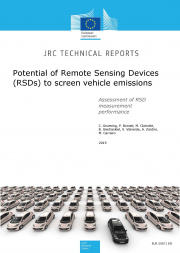
The EC Joint Reserach Centre has produced a technical report on the potential of Remote Sensing Devices (RSDs) to screen vehicle emissions summarizes the findings of a one-week measurement campaign performed in July 2017.
Two remote sensing devices from the companies HEAT and OPUS were installed on the roadside at the JRC Ispra site. Reference vehicles equipped with Portable Emission Measurement System (PEMS) were driven by the instruments serving as reference measurement systems to compare their results to the RSDs for different emissions. The focus during this exercise was on the gaseous pollutants NO, NO2 and CO from light duty vehicles. RSD and PEMS based measurements showed good agreement of the observed pollutants to CO2 ratios, the basic observable of RSDs, within the instruments range of observation.
Challenged with a larger set of different vehicles, the RSD measurements provided an overview of expected observations for different vehicle types and emission standards.
The RSD performance has been put in relation to emissions that are expected from latest EURO 6 compliant vehicles on the road using instantaneous pollution to CO2 ratios from recent Real Driving Emissions (RDE) tests. Distinguishable probability distributions for NO-to-CO2 ratios for different emission standards and single vehicles were obtained.
These findings indicate that Remote Sensing Devices constitute a promising technology for the screening of vehicle emissions in order to identify high or low polluting vehicles and vehicle types under specific driving conditions.
